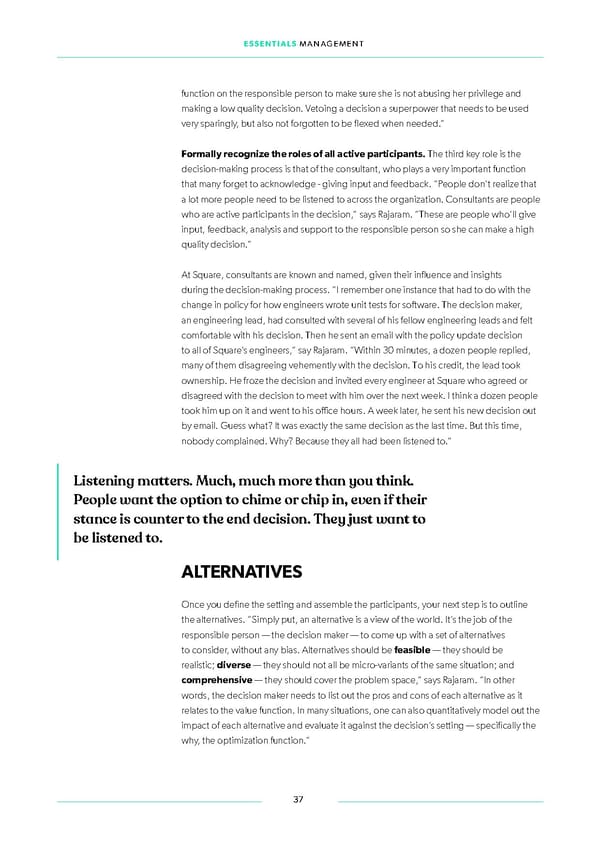ESSENTIALS MANAGEMENT function on the responsible person to make sure she is not abusing her privilege and making a low quality decision. Vetoing a decision a superpower that needs to be used very sparingly, but also not forgotten to be lfexed when needed.” Formally recognize the roles of all active participants. The third key role is the decision-making process is that of the consultant, who plays a very important function that many forget to acknowledge - giving input and feedback. “People don’t realize that a lot more people need to be listened to across the organization. Consultants are people who are active participants in the decision,” says Rajaram. “These are people who’ll give input, feedback, analysis and support to the responsible person so she can make a high quality decision.” At Square, consultants are known and named, given their inlfuence and insights during the decision-making process. “I remember one instance that had to do with the change in policy for how engineers wrote unit tests for sotfware. The decision maker, an engineering lead, had consulted with several of his fellow engineering leads and felt comfortable with his decision. Then he sent an email with the policy update decision to all of Square’s engineers,” say Rajaram. “Within 30 minutes, a dozen people replied, many of them disagreeing vehemently with the decision. To his credit, the lead took ownership. He froze the decision and invited every engineer at Square who agreed or disagreed with the decision to meet with him over the next week. I think a dozen people took him up on it and went to his oiffce hours. A week later, he sent his new decision out by email. Guess what? It was exactly the same decision as the last time. But this time, nobody complained. Why? Because they all had been listened to.” Listening matters. Much, much more than you think. People want the option to chime or chip in, even if their stance is counter to the end decision. They just want to be listened to. ALTERNATIVES Once you deifne the setting and assemble the participants, your next step is to outline the alternatives. “Simply put, an alternative is a view of the world. It’s the job of the responsible person — the decision maker — to come up with a set of alternatives to consider, without any bias. Alternatives should be feasible — they should be realistic; diverse — they should not all be micro-variants of the same situation; and comprehensive — they should cover the problem space,” says Rajaram. “In other words, the decision maker needs to list out the pros and cons of each alternative as it relates to the value function. In many situations, one can also quantitatively model out the impact of each alternative and evaluate it against the decision’s setting — speciifcally the why, the optimization function.” 37
 Essentials Management First Round Capital Page 36 Page 38
Essentials Management First Round Capital Page 36 Page 38